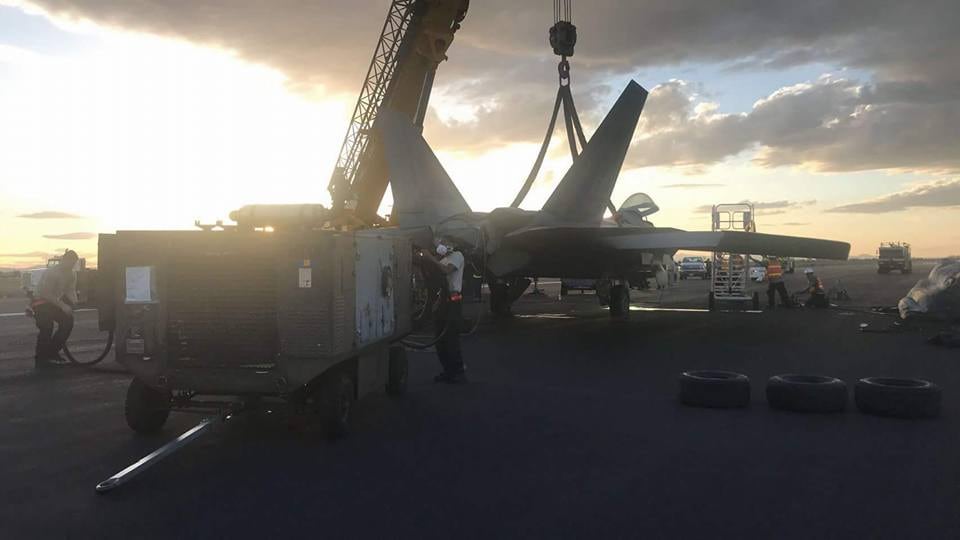An F-22A Raptor crashed and skidded on its belly during a botched takeoff in Nevada in April because its pilot was using the wrong takeoff data and prematurely retracted his landing gear, according to an Air Force investigation.
The accident investigation board report, which was posted online Thursday, concluded that pilot error was to blame for the April 13 crash at Naval Air Station Fallon. The pilot was unharmed in the mishap.
The F-22 was from the 90th Fighter Squadron in the 3rd Wing at Alaska’s Joint Base Elmendorf-Richardson, but was in Nevada to take part in a Top Gun graduation ceremony.
The Raptor’s takeoff and landing data — which is used to set the speed for rotation, or when the pilot pulls back on the stick to lift the plane’s nose, and set the takeoff pitch attitude and takeoff speed — was calculated for a 10,000-foot runway at sea level, which are conditions at Elmendorf, the report said.
However, NAS Fallon is 3,934 feet above sea level, and its runway is 13,961. What’s more, the takeoff data was calculated for an 80-degree day, but the temperature on the day of the mishap was 46 degrees.
This meant that the pilot raised his F-22′s nose and attempted to take off at airspeeds that were 16 or 17 percent lower than what they should have been. The report said the F-22 momentarily became airborne, but didn’t have enough lift to stay in the air.

The pilot also used visual clues to determine that he was airborne, the report said. But he wasn’t at the correct takeoff speed and didn’t use his instruments to verify he was climbing at the correct rate, the report said. He retracted his landing gear about 1 second after the weight-on-wheels switch indicated the landing gear was no longer in contact with the ground, which was about twice as fast as he usually did on other sorties.
At about the same time the pilot began to retract the landing gear, the Raptor’s aft section contacted the runway, and its nose began to drop down until its belly made complete contact.
RELATED

The Raptor skidded to a stop more than 9,400 feet from the runway threshold. The pilot raised the canopy and safely exited the cockpit.
Another pilot had created line-up cards earlier in the week for the Fallon sortie and three other cross-country sorties, assuming Elmendorf conditions at 80 degrees, but did not re-calculate the takeoff and landing data for each airfield.
The crash also highlights common takeoff mistakes F-22 pilots make, the report said. Every F-22 base except Nellis Air Force Base in Nevada is roughly at sea level, the report said, so their pilots frequently lift the nose up too early upon takeoff.
“There is a clear trend of rotating early among a significant number of F-22 pilots, including the [mishap pilot], despite being aware of computed” takeoff and landing data, the report said.
When pilots lift their nose, or rotate, too early, it increases their induced drag prematurely and slows down acceleration. It also leads to aircraft becoming airborne prematurely, the report said. The investigators found 80.4 percent of all pilots sampled became airborne at speeds that were at least 5 knots below their takeoff speed. This isn’t a major problem at sea level, the report said. But it can build bad habits in pilots that can lead to trouble when taking off at air fields at higher elevations, such as Fallon.
The F-22′s powerful engines, which produce more thrust than any other current fighter engine, also create “organizational overconfidence” in pilots and leads them to assume the high thrust will get them airborne.
The F-22 community “takes it for granted that we have a lot of power, and that this jet will generally take off from any runway that you want it to take off from,” one unnamed pilot told investigators.
Stephen Losey is the air warfare reporter for Defense News. He previously covered leadership and personnel issues at Air Force Times, and the Pentagon, special operations and air warfare at Military.com. He has traveled to the Middle East to cover U.S. Air Force operations.










